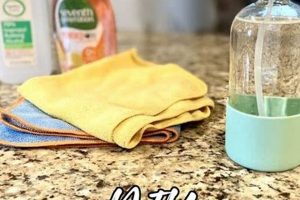Constructing a jump box independently allows for customization of dimensions to meet specific training requirements and spatial constraints. This individualized approach facilitates targeted progression in plyometric exercises. For example, an individual might build a smaller box for initial training and gradually increase the height as their jumping ability improves.
Self-assembly offers a cost-effective alternative to purchasing commercially manufactured products, especially beneficial for facilities operating on limited budgets or individuals seeking economical fitness solutions. Furthermore, this process promotes resourcefulness and a deeper understanding of equipment design, allowing for future modifications or repairs as needed. Historically, homemade fitness equipment has been a cornerstone of accessible athletic training, particularly in environments with limited resources.
The subsequent sections will detail the materials, tools, and construction steps involved in fabricating a solid and safe piece of equipment for plyometric workouts. Emphasis will be placed on safety considerations throughout the building process.
Construction Guidance for User-Assembled Jump Boxes
The following guidelines provide valuable insights into building a safe and functional piece of equipment intended for plyometric exercises.
Tip 1: Prioritize Material Selection: Opt for high-grade plywood, typically -inch thickness, to ensure structural integrity and prevent premature wear. Avoid particleboard or lower-density alternatives.
Tip 2: Precise Cutting Techniques: Employ accurate measuring and cutting techniques to guarantee square edges and uniform panel dimensions. Inconsistent cuts compromise structural stability.
Tip 3: Reinforce Seams: Apply wood glue liberally to all mating surfaces before securing with screws or nails. This strengthens the bond and enhances overall durability.
Tip 4: Internal Bracing Considerations: Integrate internal bracing, particularly for larger boxes, to mitigate potential warping or collapse under repeated impact. Cross-bracing is a recommended technique.
Tip 5: Secure Fastener Placement: Countersink all screws to prevent protrusion, minimizing the risk of injury. Ensure screws are adequately long to penetrate both layers of plywood securely.
Tip 6: Sanding and Edge Treatment: Thoroughly sand all edges and surfaces to eliminate splinters and sharp corners. A rounded-over edge profile enhances safety during use.
Tip 7: Surface Coating Application: Apply a non-slip coating to the top surface to improve grip and reduce the likelihood of slips or falls during plyometric movements. A textured paint or rubberized coating is recommended.
Tip 8: Conduct Thorough Testing: Before engaging in rigorous training, rigorously test the structure to confirm its stability and weight-bearing capacity. Subject the unit to simulated jumping forces to identify potential weaknesses.
Adhering to these principles results in a robust and reliable platform for plyometric training, contributing to enhanced athletic performance and injury prevention.
The subsequent section addresses safety considerations during the building process and while utilizing the finished product.
1. Dimensions
Dimensions are a critical determinant of the functionality and safety of a self-constructed jump box. The height, width, and depth directly influence the difficulty and applicability of plyometric exercises performed using the apparatus. For example, a taller box increases the eccentric and concentric loading on lower extremity muscles, demanding greater power output. Inadequate dimensions can compromise exercise technique, potentially leading to acute injuries or chronic overuse issues.
The correlation between jump box dimensions and user capabilities requires careful consideration during construction. A box that is too high for an individual’s current fitness level could result in failed jumps, leading to falls and potential injury. Conversely, a box that is too low may not provide sufficient stimulus to elicit meaningful training adaptations. Therefore, a progressive approach to box height, facilitated by building multiple boxes of varying sizes or a single adjustable box, is often recommended. Moreover, the surface area of the box’s top platform is equally critical, as it dictates the landing zone available. A smaller surface area increases the precision required for landing, raising the risk of missteps and subsequent injuries.
In conclusion, the dimensions are not arbitrary but rather a fundamental design parameter that affects the effectiveness and safety of the DIY plyo box. Thoughtful planning based on individual fitness levels, exercise goals, and available space is crucial for maximizing benefits and minimizing potential risks. The capacity to customize these dimensions is a primary advantage of building equipment independently.
2. Material Grade
The selection of materials is a governing factor in determining the safety, longevity, and overall performance of a self-constructed jump box. The material grade directly impacts its load-bearing capacity, resistance to deformation under stress, and susceptibility to environmental degradation. Therefore, the specifications and quality of chosen materials are critical.
- Plywood Density and Composition
Plywood, typically constructed from multiple layers (plies) of wood veneer, serves as the primary structural component. Higher-grade plywood boasts greater density, translating to increased weight-bearing capacity and resistance to warping. Marine-grade plywood, while more expensive, offers superior resistance to moisture, extending the lifespan of the jump box, particularly in humid environments. In contrast, lower-density or particleboard-based alternatives are prone to delamination and structural failure under repeated stress, rendering them unsuitable for this application.
- Fastener Quality and Type
Screws, nails, or bolts used to assemble the structure are integral to maintaining its integrity. High-quality fasteners, such as galvanized or stainless steel screws, resist corrosion and maintain their holding power over time. Conversely, inferior-grade fasteners may shear under stress or corrode, weakening the joints and compromising overall stability. The fastener type also matters; screws typically offer greater holding power than nails, especially under shear forces, making them a more secure option for critical structural joints.
- Adhesive Properties
Wood glue serves to augment the mechanical fastening methods, creating a stronger and more durable bond between plywood panels. High-quality wood glue, such as polyurethane-based adhesive, exhibits superior shear strength and water resistance, preventing joint separation and protecting against moisture damage. Inferior glues ma
y lack sufficient bonding strength, leading to joint failure under stress, or may be water-soluble, causing delamination in humid conditions. - Surface Coating Durability
A protective coating, such as paint or sealant, shields the plywood from environmental factors, including moisture and ultraviolet radiation. A durable, high-quality coating, such as epoxy paint or a polyurethane sealant, provides long-lasting protection against weathering, preventing wood rot and extending the lifespan of the jump box. Furthermore, adding aggregate to a final coat can increase friction and grip. Inadequate coatings may allow moisture penetration, leading to wood decay, or may degrade under UV exposure, leaving the plywood vulnerable to the elements.
The interplay of plywood density, fastener quality, adhesive properties, and surface coating durability collectively determines the material grade and, consequently, the robustness and safety of the self-made jump box. Scrimping on materials can introduce unacceptable risks, while investing in high-grade components ensures a durable, reliable, and safe training tool.
3. Joint Strength
Joint strength represents a critical structural element within a user-constructed jump box, directly influencing its stability and user safety. The integrity of the joints where individual plywood panels connect dictates the overall ability of the box to withstand the repetitive impact forces generated during plyometric exercises. Insufficient joint strength can lead to catastrophic failure, potentially resulting in serious injury to the user. A real-world example of this would be a scenario where a user lands a jump, and a poorly constructed joint gives way, causing the user to fall and potentially suffer a sprain, fracture, or other traumatic injury. Therefore, understanding and implementing appropriate joint construction techniques are paramount for a safe and functional piece of training equipment.
Effective joint construction typically involves a combination of mechanical fasteners and adhesive bonding. Screws or nails, when used appropriately, provide immediate mechanical strength by clamping the plywood panels together. However, fasteners alone are often insufficient to withstand the shear forces and repetitive stresses associated with plyometric training. The addition of a high-quality wood adhesive significantly enhances joint strength by creating a continuous bond between the mating surfaces. This distributes stress more evenly across the joint, reducing the likelihood of localized failure. For example, applying wood glue to all mating surfaces before securing with screws dramatically increases the load-bearing capacity of the joint compared to using screws alone. The practical application of this principle includes selecting appropriate screw length and spacing, as well as ensuring adequate glue coverage, to maximize joint integrity.
In summary, joint strength is an indispensable factor in the design and construction of a robust and safe jump box. Neglecting proper joint construction techniques compromises the structural integrity of the equipment, increasing the risk of accidents. Adherence to best practices, including the use of high-quality materials, appropriate fastening methods, and adhesive bonding, is essential to ensuring the longevity and safety of user-assembled equipment. Furthermore, rigorous testing of joint strength should be conducted before the equipment is used for training to identify and address any potential weaknesses.
4. Internal Support
Internal support structures within a self-constructed jump box are vital for maintaining dimensional stability, distributing load effectively, and preventing structural failure under repetitive stress. These elements are intrinsic to the equipment’s longevity and user safety, particularly with larger-dimensioned boxes.
- Ribs and Stringers
Ribs, typically oriented vertically, and stringers, typically oriented horizontally, provide reinforcement to the side panels, preventing bowing or flexing under load. These elements distribute force across a broader area, reducing stress concentration at the panel edges. For instance, a large box lacking internal ribs might experience panel deformation with each jump, leading to eventual joint failure and potential instability.
- Corner Bracing
Corner bracing, often implemented via triangular gussets or solid blocks, reinforces the corners where the side panels join. This mitigates the risk of corner separation and enhances the overall rigidity of the structure. An absence of corner bracing could result in the box collapsing under the impact of a jump if one of the corners gives way.
- Central Dividers
Central dividers, typically constructed of plywood, bisect the interior of the box, providing support to the top and bottom panels. This prevents sagging or buckling, especially in larger boxes subject to significant weight. A jump box lacking a central divider might experience deformation of the top panel, creating an uneven and potentially hazardous landing surface.
- Material Selection for Bracing
The material used for internal bracing should be of comparable strength and rigidity to the plywood used for the box’s exterior. Utilizing substandard materials for bracing negates the purpose of the reinforcement, potentially creating weak points within the structure. For example, using particleboard for internal bracing within a plywood box would compromise the overall strength of the unit.
The strategic implementation of ribs, stringers, corner bracing, and central dividers, constructed from appropriate materials, contributes significantly to the structural integrity and safe operation of a jump box. These internal support elements are non-negotiable for larger boxes or those intended for frequent, high-intensity use, serving as a bulwark against structural degradation and user injury.
5. Surface Traction
Surface traction, concerning a self-assembled jump box, is paramount to safety and efficacy during plyometric exercises. Inadequate surface friction elevates the risk of slips and falls, leading to potential injuries, ranging from minor abrasions to severe fractures. Conversely, appropriate surface traction ensures a secure foothold, facilitating controlled landings and efficient force transfer during jumps. The consequence of neglecting this factor is heightened risk; a real-world scenario involves a user losing footing upon landing due to a slick surface, resulting in a sprained ankle or knee injury. Thus, selection of materials and coatings impacting surface grip is a critical design consideration.
Practical implementation involves several strategies. Applying a textured coating, such as paint mixed with sand or rubber granules, generates a high-friction surface. Alternatively, adhering a pre-fabricated rubber mat to the top surface offers a durable and consistent grip. The texture should provide sufficient traction without being overly abrasive, which could cause discomfort or skin irritation. Regular maintenance, including cleaning and reapplication of the textured surface, is crucial to preserving the level of
grip over time. Furthermore, the material used must be resilient to wear and tear from repeated impacts and exposure to environmental elements. Practical applications extend to professional athletic training facilities and home gyms, where adherence to optimal surface friction standards prevents avoidable accidents and supports peak performance. Inadequate traction on a jump box can directly impede athletic performance.
In summary, surface traction is not merely an aesthetic consideration but a fundamental safety and performance parameter within the context of the user-assembled jump box. Prioritizing appropriate surface grip through material selection, coating application, and consistent maintenance mitigates injury risk and optimizes the effectiveness of plyometric training. The challenge lies in striking a balance between sufficient traction and surface comfort while ensuring the coating’s longevity. Overlooking surface traction can undermine the overall value and safety of a user-made jump box, negating its intended benefits.
6. Edge Treatment
Edge treatment, concerning a user-assembled jump box, constitutes a critical safety element, mitigating injury risks associated with sharp corners and splintered edges. The absence of appropriate edge finishing directly contributes to the likelihood of abrasions, cuts, and puncture wounds during usage. Effective edge treatment transforms potentially hazardous surfaces into safer, more user-friendly interfaces. A practical illustration is the scenario where an athlete, during a missed jump, collides with an untreated edge, resulting in a laceration. Thus, addressing edge finishing is not a cosmetic consideration but an essential component of ensuring user well-being.
Implementation strategies vary, encompassing sanding, rounding, and application of edge banding. Sanding removes sharp corners and splinters, creating a smoother, less abrasive surface. Rounding edges, achieved using a router or specialized hand tools, further diminishes impact severity by distributing force over a larger area. Edge banding, typically constructed from plastic or wood veneer, provides a durable, impact-resistant barrier that protects the underlying plywood edges. The practical application of these methods extends to both professional athletic training environments and home gyms, where the prevention of even minor injuries translates to reduced downtime and enhanced training consistency. For instance, a training facility committed to safety protocols would mandate comprehensive edge treatment on all plyometric equipment.
In summation, edge treatment forms a fundamental aspect of safe jump box construction. Neglecting this aspect introduces needless injury hazards, undermining the utility of the equipment. Prioritizing appropriate edge finishing techniques, from simple sanding to the application of robust edge banding, contributes to a safer training environment and promotes user confidence. The challenge rests in balancing functionality with cost and aesthetics, but user safety remains the paramount concern. Understanding the cause-and-effect relationship between edge treatment and injury prevention is central to responsible jump box construction.
7. Structural Integrity
Structural integrity represents a paramount design consideration for a self-constructed jump box. It embodies the capacity of the apparatus to withstand applied loads and maintain its intended geometry without catastrophic failure or unacceptable deformation. In the context of plyometric training, this translates to resisting repetitive impact forces generated during jumps and landings. A compromise in structural integrity can lead to sudden collapse, resulting in severe injury to the user. The cause-and-effect relationship is direct: insufficient design and construction practices yield reduced structural integrity, increasing the risk of accidents. For example, a box constructed with inadequate joint strength or substandard materials might buckle or break under load, causing a fall.
The importance of structural integrity extends beyond immediate safety. It affects the longevity and consistent performance of the equipment. A box with robust structural properties will maintain its shape and stability over extended use, providing a reliable platform for training. This consistency is crucial for developing proper technique and progressing through training regimens safely. Real-world examples include observing differences between commercially manufactured boxes and poorly constructed DIY attempts. Commercial products typically undergo rigorous testing to ensure compliance with safety standards, while unverified DIY projects introduce uncertainty. A practical application of this understanding involves thorough inspection of the finished product before each use, identifying any signs of weakening or damage.
In summary, structural integrity is not merely a desirable attribute but a fundamental requirement for any user-assembled jump box. Its influence permeates safety, durability, and performance aspects. Addressing challenges associated with achieving adequate structural integrity involves careful material selection, precise construction techniques, and rigorous testing. The consequences of neglecting this element extend from minor inconvenience to severe physical harm, underscoring its absolute priority in the design and construction process.
Frequently Asked Questions
The following questions address prevalent concerns regarding the independent construction of jump boxes, aiming to clarify key aspects of design, safety, and functionality.
Question 1: What is the minimum plywood thickness acceptable for a self-built jump box?
The minimum acceptable plywood thickness is inch. Lower thicknesses compromise structural integrity, increasing the risk of failure under load. High-density plywood is recommended.
Question 2: Is internal bracing necessary for all jump box sizes?
While not strictly required for very small boxes (e.g., 12-inch cube), internal bracing is highly recommended and essential for medium to large sizes (18 inches and above) to prevent bowing or collapse.
Question 3: What type of fastener is most suitable for assembling a jump box?
Screws are preferable to nails, as they offer greater holding power and resistance to pull-out forces. Galvanized or coated screws are recommended to prevent corrosion.
Question 4: How should the jump box surface be treated to prevent slippage?
A non-slip coating is critical. Options include applying textured paint, adhering a rubber mat, or incorporating sand into the final coat of sealant.
Question 5: What steps should be taken to ensure the jump box is safe before use?
Thoroughly inspect the box for any signs of damage or weakness. Test its stability by applying simulated jumping forces. Confirm that all joints are secure and the surface is non-slip.
Question 6: Can a self-made jump box be adjusted for height?
While adjustable designs exist, they are inherently more complex and potentially less stable than fixed-height boxes. If adjustability is desired, prioritize robust locking mechanisms and reinforced support structures.
Careful consideration of these points contributes significantly to the safety and functionality of a self-constructed ju
mp box.
The following section will provide detailed step-by-step instructions for constructing a standard-sized jump box.
Conclusion
This exploration has underscored the critical design and construction considerations involved in crafting a safe and functional piece of plyometric equipment. From material selection and joint strength to surface traction and structural integrity, each element contributes to the overall effectiveness and safety profile of a diy plyo box. Neglecting these aspects introduces unacceptable risks, potentially leading to injury and undermining the intended benefits of plyometric training.
Therefore, thorough planning, meticulous execution, and rigorous testing are essential prerequisites for undertaking the construction of such equipment. While cost savings and customization are potential benefits, user safety must remain the paramount concern, guiding all decisions and actions throughout the process. Diligence in adhering to established best practices will ensure a robust and reliable platform for enhancing athletic performance.







